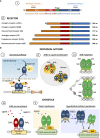Choosing the right partner in hormone-dependent gene regulation: Glucocorticoid and progesterone receptors crosstalk in breast cancer cells
- PMID: 36407312
- PMCID: PMC9672667
- DOI: 10.3389/fendo.2022.1037177
Choosing the right partner in hormone-dependent gene regulation: Glucocorticoid and progesterone receptors crosstalk in breast cancer cells
Abstract
Steroid hormone receptors (SHRs) belong to a large family of ligand-activated nuclear receptors that share certain characteristics and possess others that make them unique. It was thought for many years that the specificity of hormone response lay in the ligand. Although this may be true for pure agonists, the natural ligands as progesterone, corticosterone and cortisol present a broader effect by simultaneous activation of several SHRs. Moreover, SHRs share structural and functional characteristics that range from similarities between ligand-binding pockets to recognition of specific DNA sequences. These properties are clearly evident in progesterone (PR) and glucocorticoid receptors (GR); however, the biological responses triggered by each receptor in the presence of its ligand are different, and in some cases, even opposite. Thus, what confers the specificity of response to a given receptor is a long-standing topic of discussion that has not yet been unveiled. The levels of expression of each receptor, the differential interaction with coregulators, the chromatin accessibility as well as the DNA sequence of the target regions in the genome, are reliable sources of variability in hormone action that could explain the results obtained so far. Yet, to add further complexity to this scenario, it has been described that receptors can form heterocomplexes which can either compromise or potentiate the respective hormone-activated pathways with its possible impact on the pathological condition. In the present review, we summarized the state of the art of the functional cross-talk between PR and GR in breast cancer cells and we also discussed new paradigms of specificity in hormone action.
Keywords: chromatin; gene expression-regulation; glucocorticoid receptor; mammary epithelial cell proliferation; progesterone receptor.
Copyright © 2022 Pecci, Ogara, Sanz and Vicent.
Conflict of interest statement
The authors declare that the research was conducted in the absence of any commercial or financial relationships that could be construed as a potential conflict of interest.
Figures

Similar articles
-
Glucocorticoid and mineralocorticoid cross-talk with progesterone receptor to induce focal adhesion and growth inhibition in breast cancer cells.Endocrinology. 2004 Mar;145(3):1314-21. doi: 10.1210/en.2003-0732. Epub 2003 Nov 14. Endocrinology. 2004. PMID: 14617569
-
The glucocorticoid receptor interferes with progesterone receptor-dependent genomic regulation in breast cancer cells.Nucleic Acids Res. 2019 Nov 18;47(20):10645-10661. doi: 10.1093/nar/gkz857. Nucleic Acids Res. 2019. PMID: 31598691 Free PMC article.
-
Geldanamycin, an inhibitor of Hsp90, blocks cytoplasmic retention of progesterone receptors and glucocorticoid receptors via their respective ligand binding domains.AAPS J. 2006 Nov 22;8(4):E718-28. doi: 10.1208/aapsj080481. AAPS J. 2006. PMID: 17233535 Free PMC article.
-
Hormone receptors in breast cancer: more than estrogen receptors.Medicina (B Aires). 2019;79(Spec 6/1):540-545. Medicina (B Aires). 2019. PMID: 31864223 Review. English.
-
Genome-wide crosstalk between steroid receptors in breast and prostate cancers.Endocr Relat Cancer. 2021 Jul 22;28(9):R231-R250. doi: 10.1530/ERC-21-0038. Endocr Relat Cancer. 2021. PMID: 34137734 Free PMC article. Review.
Cited by
-
The Bovine Herpesvirus 1 Latency-Reactivation Cycle, a Chronic Problem in the Cattle Industry.Viruses. 2023 Feb 16;15(2):552. doi: 10.3390/v15020552. Viruses. 2023. PMID: 36851767 Free PMC article. Review.
-
"Diagnostic and Prognostic Biomarkers of Luminal Breast Cancer: Where are We Now?".Breast Cancer (Dove Med Press). 2023 Jul 28;15:525-540. doi: 10.2147/BCTT.S340741. eCollection 2023. Breast Cancer (Dove Med Press). 2023. PMID: 37533589 Free PMC article. Review.
-
Membrane Progesterone Receptors (mPRs/PAQRs) Are Going beyond Its Initial Definitions.Membranes (Basel). 2023 Feb 22;13(3):260. doi: 10.3390/membranes13030260. Membranes (Basel). 2023. PMID: 36984647 Free PMC article. Review.
-
Upregulation of coagulation factor V by glucocorticoid in the preovulatory follicles of zebrafish.J Steroid Biochem Mol Biol. 2024 Jul;241:106521. doi: 10.1016/j.jsbmb.2024.106521. Epub 2024 Apr 16. J Steroid Biochem Mol Biol. 2024. PMID: 38631601 Free PMC article.
-
YB-1 Expression Is Associated with Lymph Node Metastasis and Drug Resistance to Adriamycin in Breast Cancer.Dis Markers. 2023 Feb 4;2023:4667089. doi: 10.1155/2023/4667089. eCollection 2023. Dis Markers. 2023. PMID: 36785738 Free PMC article.
References
Publication types
MeSH terms
Substances
LinkOut - more resources
Full Text Sources
Medical
Research Materials

